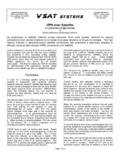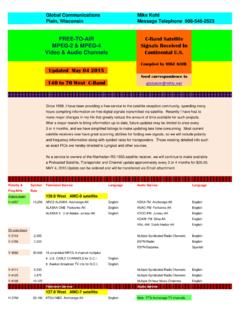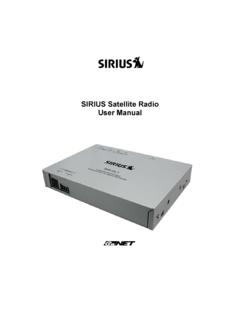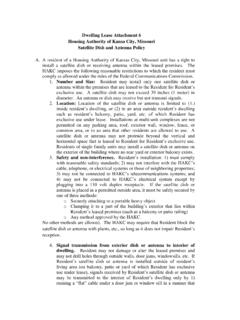Transcription of SATELLITE TV UPLINK INSTALLATION GUIDE
1 SATELLITE TV UPLINKINSTALLATION GUIDEV ersion 12/23/2010 UPLINK SITE PREPARATIONGROUNDING THE SATELLITE UPLINK SYSTEMA mandatory step in keeping your system within safe operational conditions as well as with goodperformance is the grounding of your SATELLITE good grounding system is mandatory for your equipment survivability when operated in regionssubject to lightening discharges! Another good reason is that in places where there is a lot of staticbuild up, your radio electronics will fail Outdoor Equipment (ODU) at the antenna and the signal and electrical cables running from theOutdoor Equipment to the building should be properly grounded to avoid power surges that maydamage the equipment or harm antennas shall be grounded locally, with ground rods deployed as close as cable entries at the building shall be grounded at building entry ground shall be connected to building ground by AWG#4 copper entry ground shall be connected to antenna ground by AWG#4 copper you do not provide aseparated and good ground wire between the antenna ground point andthe building entrance ground, the only connection between the two sites will be your cables andequipment!
2 If a lightning strikes in the area ( not necessarily to your antenna or building) there will beelectrical voltages and currents in the ground . Any difference of voltages between the antennaground and building ground may result in currents flowing between the two flows through the lowest resistance which path it will prefer: the earth ground path or your cables and equipment?Identify available Earth ground points available at the site. Suitable grounding consists of a copperrod driven several feet into the ground or a grounding grid that is buried and covering a large not use floating grounds or grounds occupied by motors or generators. All high power, lowfrequency motors, equipment, and generators should have their own ground the antenna-building interconnect cable as straight as possible in a direct route between the twopoints. Put additional ground rods at each 15 feet.
3 Put ground rods at each sharp corner or turn ofwire ODU ground must be connected to the Earth ground or to the antenna. The 000 AWG multi-conductor copper wire is recommended to bond units together to the earth ground using the shortest(direct) LNB is grounded to a lug on the antenna feed ground cable on the antenna is fastened to an Earth ground. This earth ground point should notbe shared with the indoor also need to ground the coax cable inside of the building with a special coax grounding is normally done near the point of entry into the red arrow points to where your grounding cable will connect to this the coax cable needs to be grounded, it MUST NOT be part of the grounding circuit for the sure you ground all the items:-Transmitter & LNB-Feed Arm-Non-Penetrating or king post or pedestal coaxial cables entering the building must go through a grounding block as shown in the pictureGrounding blocks are normally found in the section of the hardware store for TV MAKE SURE THAT THE UNIT AND CABLES ARE PROPERLY GROUNDED TO AVOIDDAMAGES TO THE EQUIPMENT AND RISK TO PERSONEL !
4 DAMAGES DUE TO POWERSURGES WILL VOID THE WARRANTY!OUTDOOR EQUIPMENT INSTALLATION Make sure the N-type connectors for the IF cables are securely fastened to the RF unit (boththe Tx & Rx). Make sure the connectors are wrapped with mastic tape to prevent corrosionand water entry. The cables to the LNB should be fastened properly, tightened, and taped. The waveguide from the RF unit to the feed should be fastened properly with the propergaskets and silicone. Inspect waveguides for any damages- even a tiny hole can reduce the performancedrastically. Avoid overloading the antenna with heavy ODU that may cause dish distortion overtime. Whenever possible install ODUs in a manner that the fans and heatsink fins are facing downto minimize accumulation of dust, sand and debris. Keep fans running smoothly clean or replace them in case of slowing down. Attempt to shake the antenna. If large movement patterns exist, then the fastening of thebolts was not performed WITH LNBsFit the LNB with a suitable feed horn and attach to the antenna ensuring correct LNB a suitable 75 ohms low loss coaxial cable ( RG6 or RG11 )between the receiver RF inputand the LNB.
5 The connection to the LNB should be protected with self-amalgamating L Band receiving frequency is calculated as:LNB LO Frequency C Band RX Frequency = L Band RX FrequencyC Band LNBs typically cover the whole C Band frequency range and have a LO of 5150 MHzKU Band LNBs typically come in different frequency ranges as GHZ LO GHz - Some manufacturers refer to as C GHZ - LO - GHZ LO GHz - Some manufacturers refer to as A Type or US - GHZ LO GHz - Some manufacturers refer to as B TypeThere are different types of LNBs in terms of frequency tuning stability:DRO (typically +/- 150 KHz to +/- 500 KHz )PLL Internal Reference ( +/- 2 ppm to +/- 10 pmm or +/- 28 KHz to +/- 140 KHz in KU Band )PLL External Reference ( +/- 1 ppm or better or +/- 14 KHz in KU Band )For reception of TV and other larger carriers, a DRO LNB is usually sufficient. Narrower carriers mayrequire a PLL ALIGNMENT / POINTINGC lear Line of SightThe antenna must have a clear line of sight view of the SATELLITE .
6 This means that the pointing anglemust be clear of tall buildings, trees and other high objects. If the view to the south is generally clearthe antenna site will be suitable. However if there are obstructions to the south the actual pointingangles will have be checked to see if the site is PositionMost communications satellites appear stationary in the sky from any location on the earth. This isbecause their speed is matched to the rotational speed of the earth taking into account the fact thattheir orbit is much greater than the earth s circumference. These satellites are said to be ingeostationary or geosynchronous satellites can only have one orbit, which is 22,238 miles (35,786 kilometers) directlyabove the direction an antenna must point in order to receive the signal from a given SATELLITE is determinedby the antenna s location north or south of the equator and the position on the equator over which thesatellite is SATELLITE s position is given in degrees of latitude and longitude in the same manner as a position and LongitudeLatitude is measured in degrees north or south of the equator which is at 0 degrees latitude.
7 Therange is from 90 degrees north via 0 to 90 degrees is measured in degrees east or west of the Prime Meridian. The Prime Meridian is at 0 longitude and is an imaginary line running north/south on the earth s surface from the north pole to thesouth pole and passing through the Greenwich Observatory in England. All other points in the worldare either east or west of this line. There are 360 of longitude expressed as 0 to 180 east and 0 to180 west. 180 E is the same location as 180 W and this position is the International Date Line. Thelatitude of a SATELLITE is the same as that of the location on the equator directly below the purpose of calculation, latitude and longitude are represented as decimals. The sign of thedecimal is used to distinguish North (positive) and South (negative), and East (positive) and West(negative).Coordinates of a site can be easily obtained by a GPS or specialized web Pointing AnglesThe Azimuth and Elevation angles along which an antenna must point to receive a particular satellitessignal can be calculated.
8 The information required for the calculation is the location, in latitude andlongitude, of the antenna and the longitude of the ToolsThere are web pages that allow the easy and fast calculation for SATELLITE antenna pointing angles,based on the site address or coordinates and the SATELLITE orbital very useful reference , which also provides calculation of obstacle heightclearance for a given location and a should obtain also some additional information about the SATELLITE such as a list of TV channelsthat are on that SATELLITE (the best known web page for that purpose ) .Most of the satellites have one or more beacon frequencies, which are clear-carriers (CW), non-modulated signals at specific frequencies , that allow the users to identify whether they are pointed tothe correct SATELLITE in an easier all Information Needed before Starting the Antenna PointingSatellite LongitudeSatellite Beacon FrequenciesPointing AnglesTx Frequency and PolarizationRX Frequency and PolarizationEventual FTA (Free to Air) TV Channels on same SATELLITE , band and polarizationObtain other frequencies of interest that may help to identify the SATELLITE .
9 Try to obtain asatellite spectrum plot with the SATELLITE spectrum analyzers can store the spectrum plots of different satellites, a very helpfultool to identify the Instruments for Antenna Pointing:Sighting compass to align the antenna in azimuthInclinometer to set the elevation InstrumentsL Band Spectrum AnalyzerDVB-S FTA (Free to Air) ReceiverSmall TV MonitorAntenna Off-SetMost common type of small antennas in the market is the off-set antenna. In off-set antennas, theactual line of sight of the antenna is off set from the apparent visual line of sight. The dish is actuallypointed to a higher elevation that it seems. Subtract any antenna offset from the required elevationangle when measuring. For example, if your SATELLITE elevation angle is 23 degrees and the dish off-set is 23 degrees, the antenna elevation angle should be 0 degree the antenna should be appear tobe horizontal but actually pointing to 23 degrees.
10 This subtraction allows to place the inclinometer atthe back structure part that is parallel to the reflector dish. Some antenna manufactures alreadyprovide a surface at the back structure that takes in account the off-set angle and in this case no off-set is needed calculation is needed. Please refer to antenna with the ElevationFirst all make sure that the antenna support platform and pedestal tube are leveled!Adjust the antenna elevation as accurate as is the AzimuthAlign the antenna azimuth pointing with a magnetic compass; attention antenna pointing angles arecalculated for geographical azimuth angles; the use of magnetic compass needs to consider themagnetic declination. Typically, the support web pages provide already the magnetic azimuth to possible align the antenna azimuth by using a reference or placing the compass in front of theantenna and as far as possible ( 15 feet or more) the farther you go more accurate will be theazimuth I on the Correct SATELLITE ?









